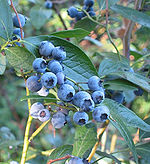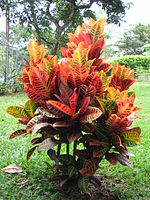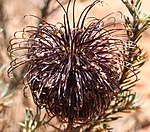From Wikipedia, the free encyclopedia
COPIED TO ARTICLE-SPACE 5 April 2020
MOVED TO Stearn's botanical names (U–Z) 6 April 2020
The Linnean Society headquarters in Burlington House William T. Stearn (1911–2001) was one of the preeminent British botanists of the 20th century, a president of the Linnean Society and the original drafter of the International Code of Nomenclature for Cultivated Plants Royal Horticultural Society (RHS) from 1934 to 1952, apart from the war years, and worked in the 1950s as Botany Librarian at the British Museum. Brent Elliott , another longtime Librarian (and later Historian) of the RHS, described the 1992 edition of Stearn's Dictionary of Plant Names for Gardeners as the "most authoritative account of botanical names and their meanings". This book benefited from Stearn's work with the botanical collections of the Natural History Museum , Kew Gardens and the Linnean Society. His textbook on Botanical Latin , first published in 1966, also became a standard.
The Latin and Greek species and genus names come from the Dictionary of Plant Names , omitting names derived from people and places, names that have since been relegated to synonym status, and a few species names with alternative suffixes. The more recent history and meanings of the binomial names themselves are also omitted. Although the selection comes from Stearn, the definitions provided reflect a variety of modern authorities. Species names may appear with any of their nominative singular endings. The second column uses "L" for Classical (or occasionally Medieval) Latin, and "G" for Ancient Greek ; other languages of origin are not covered.
Botanical names, V–Z [ edit ] Vaccinium corymbosum Yucca valida Codiaeum variegatum Myoporum velutinum drawing of Ensete ventricosum Calochortus venustus Iris versicolor Aloe vera Fragaria vesca Aldrovanda vesiculosa carnivorous plant Vinca minor Vitis vinifera Banksia violacea Panicum virgatum ears of maize (corn, Zea mays ginger root (Zingiber officinale cooked wild rice (Zizania palustris
Species or genus
LG
Latin and Greek meanings
Examples
Ref.
Vaccaria L
From vacca (cow)
Vaccaria hispanica
vaccinifolium or vacciniifolium
L
with leaves like Vaccinium
Quercus vacciniifolia
vaccinioides
L
like Vaccinium
Symphoricarpos vaccinioides
Vaccinium L
Latin name for some berry bushes
Vaccinium corymbosum
vacillans
L
variable
Vaccinium vacillans
vagans
L
widely distributed; wandering
Erica vagans
vaginatus
L
sheathed
Cyperus vaginatus , Carex vaginata
Valeriana L
this plant, in Medieval Latin
Valeriana officinalis
Valerianella L
diminutive of Valeriana Valerianella locusta
validus
L
strong; well-developed
Yucca valida
Vallaris L
from vallus (sharpened stake)
Vallaris glabra
vallicola
L
valley-dweller
Carex vallicola
variabilis
L
variable
Pseuderanthemum variabile
variegatus
L
variegated
Codiaeum variegatum , Bauhinia variegata
varium
L
diverse
Phlegmariurus varius , Hakea varia
vegetus
L
vigorous
Astragalus vegetus
vellereus
L
shaggy
Ballota vellerea
velox
L
quick (rate of growth)
Rubus velox
velutinus
L
velvety
Myoporum velutinum , Quercus velutina
venator
L
hunter
Rhododendron venator
venenata
L
poisonous
Alstonia venenata
venenosa
L
very poisonous
Toxicoscordion venenosum
venosum
L
heavily veined
Rumex venosus , Haworthiopsis venosa
ventricosus
L
ventricose (swollen, often on one side)
Bambusa ventricosa , Ensete ventricosum
venustum
L
beautiful, graceful
Calochortus venustus , Pyrostegia venusta
Veratrum L
true black
Veratrum nigrum
verbascifolius
L
Verbascum Celmisia verbascifolia
Verbascum L
originally derived from barba (beard)
Verbascum thapsus
Verbena L
sacred bough
Verbena officinalis
Verbesina L
like Verbena
Verbesina alternifolia
verecundus
L
modest; shy
Boronia verecunda
veris
G
of spring
Primula veris
vermiculatus
L
wormlike; having waving lines
Salsola vermiculata
vernicifluum
L
yielding varnish
Acacia verniciflua
vernicosus
L
varnished
Rhododendron vernicosum , Eucalyptus vernicosa
vernus
L
of spring
Ficaria verna , Leucojum vernum
verrucosus
L
warty
Sesuvium verrucosum Hymenaea verrucosa
verruculosa
L
a bit warty
Berberis verruculosa
versicolor
L
variably colored
Iris versicolor
verticillatum
L
whorled
Plectranthus verticillatus , Banksia verticillata
Verticordia L
a myrtle species
Verticordia plumosa
verum
L
true
Aloe vera
vescum
L
small; feeble; edible
Fragaria vesca
vesicarius
L
with bladders or vesicles
Carex vesicaria
vesiculosum
L
with small bladders or vesicles
Aldrovanda vesiculosa
vespertilionis
L
(wings) of a bat
Christia vespertilionis
vespertinum
L
(flowering) in the evening
Asplenium vespertinum
vestitus
L
clothed; covered
Leucospermum vestitum Acacia vestita
vexans
L
troublesome
Buddleja vexans
vexillaris
L
with a flag
Pachycarpus vexillaris
Viburnum L
the wayfaring tree
Viburnum opulus
Vicia L
a vetch
Vicia ervilia
viciifolia
L
Vicia Onobrychis viciifolia
victorialis
L
victorious
Allium victorialis
villosus
L
hairy
Vicia villosa , Solanum villosum
viminalis
L
willow-like
Salix viminalis , Cynanchum viminale
Vinca L
a contraction of its Latin name
Vinca minor
Vincetoxicum L
conquering poison
Vincetoxicum hirundinaria
vineale
L
of vines
Agrostis vinealis
vinifera
L
yielding wine
Vitis vinifera
vinosus
L
like wine
Nautilocalyx vinosus
Viola L
one of several fragrant plants
Viola odorata
violaceus
L
violet-colored
Stylidium violaceum , Banksia violacea
violascens
L
turning violet
Pitcairnia violascens
virens
L
green
Rhus virens
virescens
L
turning green
Echium virescens
virgata
L
twig-like
Homoranthus virgatus , Panicum virgatum
virginalis
L
virginal; white
Disa virginalis
virgultorum
L
of bush hedges
Solanum virgultorum
viridescens
L
turning green
Ferocactus viridescens
viridiflorum
L
green-flowered
Narcissus viridiflorus , Asclepias viridiflora
viridis
L
green
Veratrum viride
viridissima
L
greenest
Forsythia viridissima
viridulum
L
somewhat green
Nassella viridula
viscidifolia
L
sticky-leaved
Rhododendron viscidifolium
viscidum
L
sticky
Phacelia viscida Diplacus viscidus
viscosus
L
sticky
Dittrichia viscosa , Rhododendron viscosum
Viscum L
mistletoe
Viscum album
vitaceum
L
like a vine
Piper vitaceum
vitellina
L
yolk-colored
Xanthophyllum vitellinum
Vitex L
this tree, possibly
Vitex agnus-castus
vitifolium
L
Vitis Passiflora vitifolia
Vitis L
grapevine
Vitis vinifera
vittatum
L
striped (lengthwise)
Hakea vittata
volubilis
L
circling around
Dichelostemma volubile
volutum
L
caused to roll
Epidendrum volutum
vomitoria
L
causing vomiting
Ilex vomitoria
vulcanicum
L
of volcanos
Peperomia vulcanica
vulgaris
L
common
Marrubium vulgare
vulpinus
L
of foxes
Vitis vulpina
xanthina
G
yellow
Acacia xanthina
Xanthisma G
yellow quality
Xanthisma texanum
xanthocarpa
G
yellow-fruited
Acacia xanthocarpa
xanthochlora
G
yellow-green
Alchemilla xanthochlora
Xanthoceras G
yellow horn
Xanthoceras sorbifolium
xantholeuca
G
yellow-white
Caladenia xantholeuca
Xanthorhiza G
yellow root
Xanthorhiza simplicissima
Xerophyllum G
dry leaf
Xerophyllum asphodeloides
zaleucum
G
very white
Rhododendron zaleucum
Zamia L
pine cone
Zamia furfuracea
Zanthoxylum G
yellow wood
Zanthoxylum americanum
Zea G
some ancient Greek cereal grain, possibly spelt
Zea mays
Zephyranthes G
west-wind flower
Zephyranthes atamasca
zibethinus
G
(stinking) like a civet, from Medieval Latin zibethum (civet)
Durio zibethinus
Zigadenus G
yoked glands
Zigadenus glaberrimus
Zingiber G
ginger
Zingiber officinale
Zizania G
some ancient Greek wild grain
Zizania palustris
zonata
L
banded
Cryptanthus zonatus
Zygopetalum G
yoked petal
Zygopetalum maculatum
Five of the six books used as sources arrange all entries alphabetically; page numbers are provided only for Coombes.
References [ edit ] Coombes, Allen (2012). The A to Z of Plant Names: A Quick Reference Guide to 4000 Garden Plants . Portland, OR: Timber Press. ISBN 978-16046-91962 Gledhill, D. (2008). The Names of Plants . New York, NY: Cambridge University Press. ISBN 978-05218-66453 Harrison, Lorraine (2012). Latin for Gardeners: Over 3,000 Plant Names Explained and Explored . Chicago, IL: The University of Chicago Press. ISBN 978-02260-09193 Lewis, Charlton (1891). An Elementary Latin Dictionary . Oxford, UK: Oxford University Press. ISBN 978-01991-02051 Perseus Digital Library .Stearn, William (2002). Stearn's Dictionary of Plant Names for Gardeners . London, UK: Cassell. ISBN 978-03043-64695 Stevenson, Angus (2007). Shorter Oxford English Dictionary . Oxford, UK: Oxford University Press. ISBN 978-01992-06872 The Linnean Society (August 1992). "Publications by William T. Stearn on bibliographical, botanical and horticultural subjects, 1977–1991; a chronological list". Botanical Journal of the Linnean Society 109 (4): 443–451. doi :10.1111/j.1095-8339.1992.tb01443.x .


















